Down to the Sea in Ships
Today we’re finishing up the tour of the SF Maritime Museum on April 6. On that day we explored several parts of the museum but ran out of time and didn’t get around to exploring the several ships they also have. We parked again in our favorite garage and walked down the waterfront from Pier 33, near the parking garage, to Pier 45, where the ships are. They have a whole slew of boats and ships but some are still being refurbished and redone. There are 6 ready for touring and we we headed for the largest, a square rigged sailing ship, the Balclutha.
We actually came on what the National Parks had designated as a free weekend. We’ve heard of theses but have never been around a National Park to take advantage of this. Well, today we are but, we appreciate the National Parks so much, derive such enjoyment from them and know of their financial struggles that we donated an equal amount to what we would have paid. We’re afraid that budget cutters in Congress will see the National Parks as so much fluff that they will cut them to the nubbins and begin to close some of them. They may not add much to our bottom line as a nation but they add to our top line, to our way of life, our pride and to our sense of well being
But, back to the Balclutha. She has had 3 names in her history: Balclutha, Star of Alaska and Pacific Queen and has actually appeared in a movie. She actually was built in 1886 in Glasgow in Scotland. She was built to be a general trader though the major cargo that she carried was American grain to England in exchange for fancy goods such as Scotch whiskey, cutlery, etc. Interestingly, it was cheaper to ship the grain around South America than transport it across the US by train. On the other hand, grain was a treacherous cargo to carry since it could shift dangerously whenever the ship tilted and could absorb water should leakage occur in the grain hold. Thus it had to be stored very carefully so it would not shift and in water tight bags so it would not get wet.
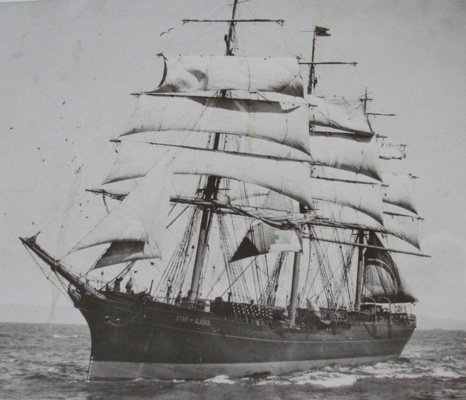
Then she was sold in 1899 and bought to carry lumber from north west America to Australia for the mines. She carried a total of 1.5 million board feet for the Broken Hill Mine at Port Pirie, Australia.
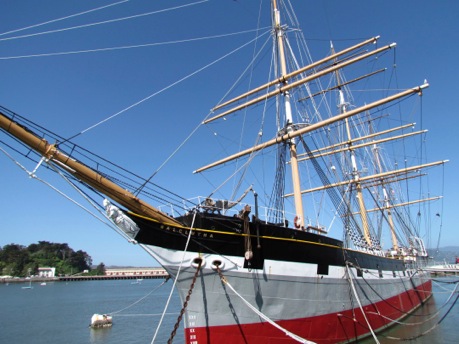
Finally she was bought by the Alaska Packers' Association for $500. She was renamed the Star of Alaska and carried supplies and fishermen up to Alaska for the salmon season and brought the prepared salmon back to America.
She’s lived an extremely busy life and has traveled all over the globe, and, as one of the few square riggers left, she is now serving as a museum. In her life she has also been a film star, having appeared in the film Mutiny on the Bounty starring Clark Gable and Charles Laughton. She then eked out an existence as an exhibition ship, gradually deteriorating. Ouch.
Luckily, in 1954, she was acquired by the San Francisco Maritime Museum, which restored her and renamed her back to Balclutha. The NPS has done a very good job of using the Balclutha as a museum. They are restoring it (with volunteers) to its original glory. Much has been done but there is still much to be done. We could go throughout the ship and see the various sections; There were 3 separate areas in the hold along with 3 separate films about her life as a grain hauler, lumber hauler and in the salmon trade and there were examples of each of its cargoes. A great insight into trade during the 19th and 20th centuries.
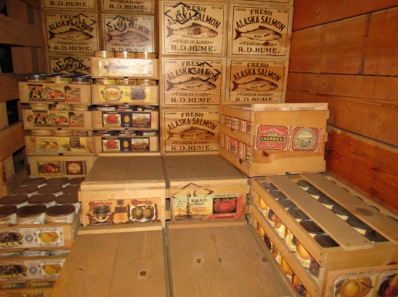
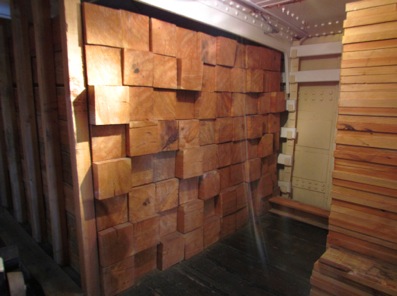
We also learned about life aboard a trading ship - not always pleasant. As we looked up into the rigging of the ship, we tried to imagine climbing the rigging barefoot in a gale with gusts of wind blowing the ship around, water washing over the decks and loose rigging whipping around. And, of course, it is in the worst of gales that you need to go up into the rigging. Here’s a storm almost swamping the ship.

Food: none too good. Bunks: none too comfy. Punishment: sure enough - beatings for tipping a bucket of tar. We learned that British ships were known as ‘hungry’ ships and, while the American ships fed their crews better, they were infamous for the brutality of their officers. Being a sailor was not an occupation chosen by many and often officers had to fill their crews with men who were ‘shanghaied’ at night when they were drunk and leaving seaport bars late. Many then work up the next morning far out at sea and a sailor for the duration of the passage.
Here is the bunk area of the Balclutha, right in the prow of the ship. Notice the holes where the anchor chains leave the ship and try to imagine sleeping here. One sailor told of not tying his stuff tightly down in his bunk and, when the seas got nasty, the water rolled in through these holes and swept his stuff out the door, onto the deck and out to sea. In the picture below you can see the bunks, one above the other in rows in the bow of the ship.
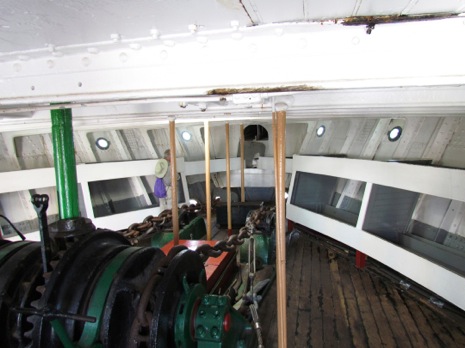
The second ship we saw was the Eureka, a double-ended passenger and car ferry built in 1895 and used in the San Francisco area, running until 1957 when its usefulness faded as more bridges were built. Double-ended with interchangeable bows and sterns so it would not have to turn around as it shuttled between terminals. Here’s my favorite picture of the day: showing Rte 101 ending at the ferry terminal.
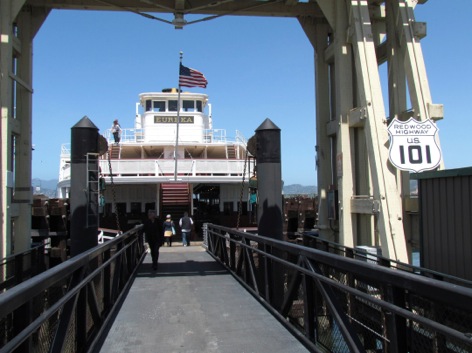
Yes, if you wanted to continue your trip via Rte 101 and head north, you had to drive aboard this ferry and take it across the Golden Gate, before the bridge was build. Many also took the ferry everyday into work before the bridges were built over the Golden Gate and over the bay.
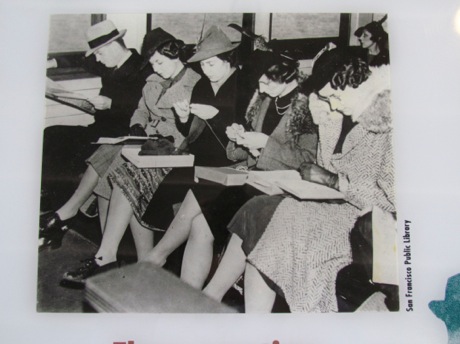
The Eureka was extremely fast since she was built like a racing yacht underneath. Looks like she’d tip, doesn’t it?
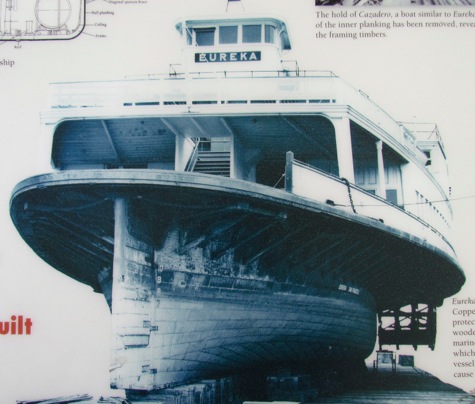
We scanned the other ships there but wanted to get on to the SF Fire Department Museum. Interestingly, there is no SF History Museum. You can get Maritime history at the SF Maritime Museum, you can get fire department history at the Fire Department Museum, you can get Chinese in SF history in Chinatown but there is no one place where you can get SF History all in one place. You’ve got to piece it together from other museums. You’d think that SF history is so rich that there would be a historical society chomping at the bit getting a museum in order.
The Fire Department Museum was a very nice museum and they had taken great care in putting it together. We were told that a college student majoring in Museum Studies and planning to be a curator put lots of it together and wrote most of it up. There were fire trucks galore (we learned that red paint cost more than others because it had more pigments. Thus fire departments took that color since it would stand out.) The early fire trucks were pulled by the firemen (see the picture below) and, when horses began to be used, they could get to more fires faster. Steam engines were even better.
Obviously, the early engines were pulled by horses. When the fire bell rang, the latches on the stalls automatically released and the horses would spring into action and assume their assigned place in front of the fire engine.
A device in the ceiling that held their harnesses, bridles and bits would lower from the ceiling and place the gear over the horses’ heads. A firemen would quickly buckle all into place, the device retracted and they were off. Pretty slick. The horses were an integral part of the team and quickly learned to position themselves as needed and calmly follow instructions when all about them was chaos and the fire roared.
Here’s a bed key? Huh, a bed key? It seems that firemen not only fought the fire but also sometimes salvaged what they could from the burning home. Since the most important item many families owned was the bed, they had these keys so that they could disassemble the beds as quickly as possible.
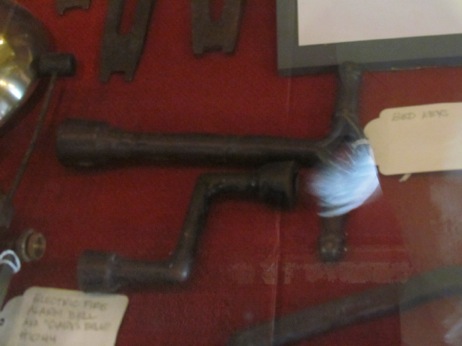
Here’s an early fire engine with the hose nozzle pointing straight up. Obviously, they couldn’t get to many fires that way. The great invention was flexible, rollable fire hoses. Now they could get more hose to the fire, shoot the water in many more directions and get it much higher. Hoses can even be carried up ladders. Wow, who would have thought that flexible rollable hoses weren’t used in the beginning?
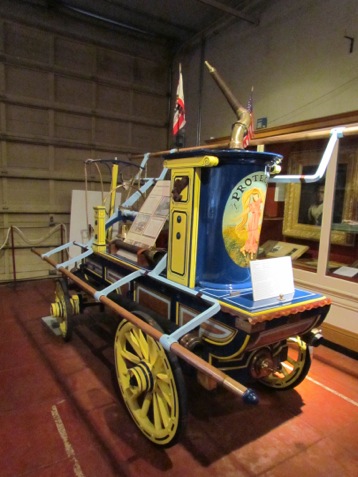
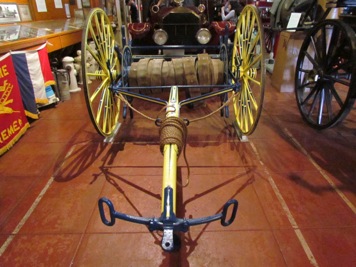
Did you know there was a special tool for twisting off the caps of fire hydrants? Well, duh. Of course. Yeah, but I had never thought of it. Most of the museum was dedicated to all of the separate fire houses in the city with scores of pictures of the men and their firehouse. There was some information about the earthquake in 1906 and the fire that spread after it. Here are some maps showing how the fire spread throughout the city in the three days after the quake. Note in the 4th picture that the fire stopped on on a corner. This is where the gold fire hydrant was.
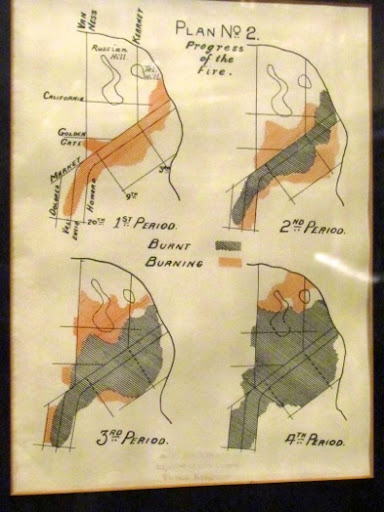
And here are some pennies that fused together in the heat of the fire.
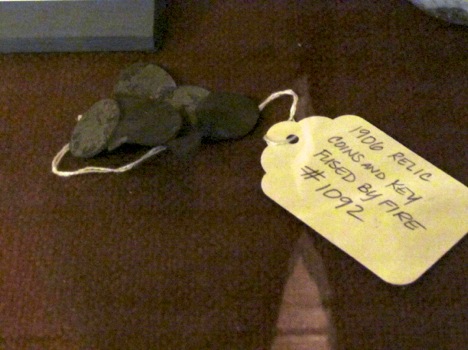
On our way home, we decided to hit Twin Peaks, one of the highest points in San Francisco. And - you can drive up - whew. We circled around the peaks and found a place to park, amidst all the other tourists who had chosen today to get their views of SF.
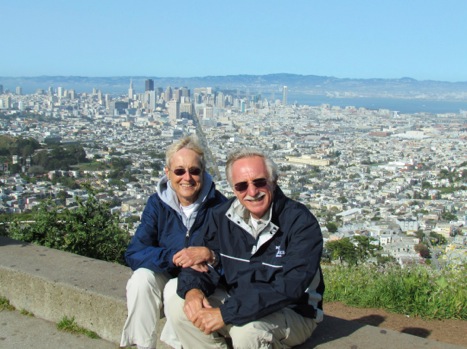
And, then finally home.

wow you guys still looking young. Nice pictures.
ReplyDeleteKids Car Beds